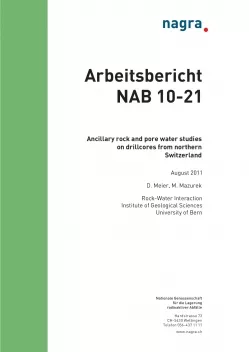
Arbeitsbericht NAB 10-21
Ancillary rock and pore water studies on drillcores from northern Switzerland
A laterally extended, about 300 – 600 m thick low-permeability sequence mainly dominated by clay-rich lithologies occurs between the Malm and Triassic (Keuper or Muschelkalk) aquifers of northern Switzerland (an example is provided in Fig. 1). It includes, among other units, three formations that have been proposed by Nagra (2008) as host rocks for various types of radioactive wastes. The five potential siting regions in northern Switzerland and the corresponding host rocks (Opalinus Clay, the overlying 'Brauner Dogger' and the Effinger Schichten) are shown in Fig. 2.
This report revisits existing drillcore materials from older boreholes in the region of interest and documents the results of a new analytical campaign. The objectives were to study the spatial distribution of natural-tracer concentrations in pore water at locations where this has not been done previously and to augment the mineralogical data base with respect to the newly proposed host rocks 'Brauner Dogger' and Effinger Schichten. The present report has the focus on the tracer profiles. The mineralogical data of the host-rock sections are analysed in Mazurek (2011).
One of the motivations for this report was the success of the campaign for the Benken borehole, where regular profiles of Cl-, δ18O and δ2H were identified across the whole low-permeability sequence (Gimmi & Waber 2004, Gimmi et al. 2007). In that campaign, the tracer profiles, together with the known tracer concentrations in the bounding aquifers and palaeohydrogeological constraints, were subjected to transport modelling, in order to reproduce the observed profiles using plausible transport parameters and evolution scenarios. That study, together with a suite of studies related to other European sites (Mazurek et al. 2009, 2011), provided valuable information pertaining to transport mechanisms and parameters and thereby yielded constraints with regard to the long-term evolution of low-permeability sequences.
In this study, core materials from the low-permeability sequence illustrated in Fig. 1 have been sampled in the boreholes of Weiach (WEI; Matter et al. 1988a, Nagra 1989), Riniken (RIN; Matter et al. 1987, Nagra 1990) and Schafisheim (SHA; Matter et al. 1988b, Nagra 1992), together with additional materials from the Benken borehole (BEN; Nagra 2001). Given the fact that the original pore water is no longer present in these core materials, the spectrum of tracers that could be studied was limited to Cl- and Br-. These precipitated as salts when the pore water evaporated but are still present in the rock, unaffected by the environmental conditions during core storage (air humidity, oxidising regime).
